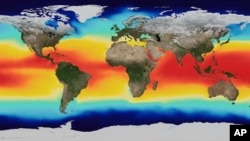The U.S. space agency NASA launched a new satellite observatory Friday that will measure the saltiness of the world’s oceans. Scientists hope to learn what impact changes in ocean circulation and the salinity of the seawater are having on the globe’s changing climate.
Most of the Earth’s water cycle of rainfall and evaporation occurs over the oceans. At the same time that global temperatures are rising, scientists for more than a century have noted from shipboard and buoy measurements a change in global water cycle and ocean circulation patterns.
These changes in rainfall and evaporation have led to a gradual cooling of sea surface temperatures in some places and warmer waters in others.
To get a global view of how changes in the water cycle might be affecting climate, NASA scientists will be measuring the salinity, or the amount of salt dissolved in seawater with the Aquarius satellite.
Experts say the $287 million orbiting observatory will be able to measure ocean salinity within an eighth of a teaspoon, or a pinch of salt, per gallon of water.
Gary Lagerloef of the non-profit Earth and Science Research Institute in Seattle, Washington is Aquarius’ principal investigator.
Lagerloef says the Aquarius mission will focus on studying the interaction between global water cycle, the ocean circulation and how these interactions influence climate and climate variability.
“One of the big overarching questions in climate is, is the global water cycle changing? Many climate forecasting models suggest that it will change over time as the climate warms up," he said. "But measuring these changes in rainfall over the ocean is very, very difficult to do. But salinity is actually a very important parameter of what might be going on.”
The Aquarius will generate monthly maps of saltwater circulation around the globe. Ocean water is saltiest in regions where evaporation is greater than rainfall and there’s less ocean salinity in places where rainfall exceeds evaporation.
The Aquarius satellite is equiped with a suite of onboard instruments contributed by Canada, France and Italy to measure ocean salinity, including radiometers that will detect microwaves from the surface of the world’s oceans as the observatory orbits every seven days.
Yi Chao, project scientist with the Aquarius mission at NASA’s Jet Propulsion Lab in Pasadena California, says the radiometers are like very precise, sensitive radio receivers.
"They collect the emissions from the ocean’s surface and different salt concentrations of the ocean emit different energy," Chao said. "So once you have this emission measure from the radiometer, scientists go through the series of mathematic equations and formulas or you can think about a number of look-up tables to derive the salinity and to deliver the data required to answer those science questions.”
The Aquarius satellite, a collaboration between NASA and the Argentine space agency will join 13 other U.S. satellites devoted to studying the Earth, including rainfall levels, evaporation, sea levels and winds.










